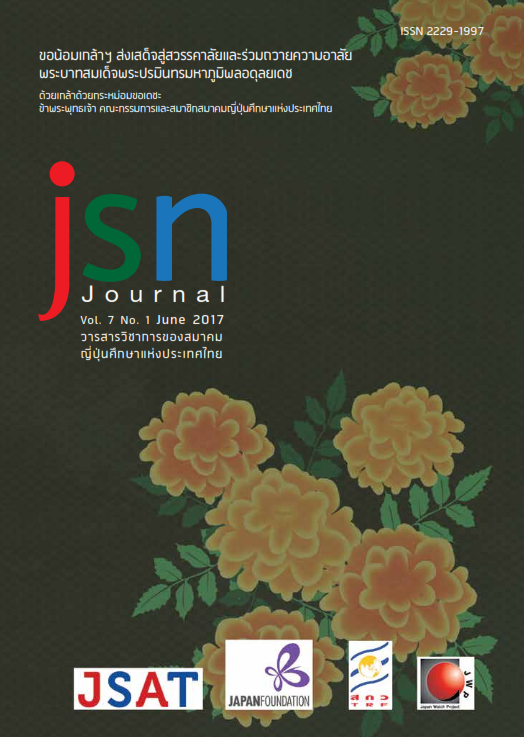A Study on Hell Painting Research in Japan: Its Development and Supporting Factors in Modern Japan
Main Article Content
Abstract
The concept of hell can be found in many countries, not only in manuscripts or through textual evidence, but also in art works such as paintings and prints. Those art works have been used as evidence by researchers in order to investigate the concept of hell or related subjects. This article’s objective is to study the development of hell painting research and the supporting factors in Japan after WWII (after the occupation) in order to investigate the trends, problems, and prospects of conducting research on the topic. However, the scope of this paper is limited to Japanese hell painting research in Japan. According to a survey for this study, research in this area has increased from the 1960s although there has been a lack of continuity. In the 1990s, the rise in the amount of the research and its variety of topics can be noticed significantly. After that, the research reached its peak in the 2010s. This development may have been supported by the changes in society, Buddhism in modern Japan, the trend of Japanese hell painting exhibitions, and studies on East Asian countries’ hell painting and exhibitions related to the subject in Japan. Though the research on Japanese hell painting in Japan has developed since the 1960s, many problems can be noticed, for instance, the lack of examples, especially regarding the paintings created after the latter part of the 16th century, and the need for background information to understand and analyze the works and their history more thoroughly.
Article Details
ข้อความและข้อคิดเห็นต่างๆ ในบทความเป็นของผู้เขียนบทความนั้นๆ ไม่ใช่ความเห็นของกองบรรณาธิการหรือของวารสาร jsn Journal
References
พวงทิพย์ เกียรติสหกุล. (2555). ญี่ปุ่นกับการเปลี่ยนแปลงทางเศรษฐกิจหลังสงครามโลกครั้งที่ 2 ค.ศ. 1945-1975. นครปฐม: โรงพิมพ์มหาวิทยาลัยศิลปากร.
Gordon, A. (2003). A Modern History of Japan: From Tokugawa Times to the Present. New York: Oxford University Press.
Kingston, J. (2011). Contemporary Japan: History, Politics and Social change since 1980s. Chichester: Wiley-Blackwell.
Reader, I., & Tanabe Jr., George J. (1998). Practically Religious: Worldly Benefits and the Common Religion of Japan. Honolulu: University of Hawaii Press.
井手誠之輔 (2001). 『日本の美術 418 日本の宋元画』 .東京:至文堂.
井上啓治 (1993). 「『本朝酔菩提全伝』 『善知安方忠義伝』 における〈地獄絵・地獄 信仰〉−京伝考証における認識・主題形成と読本作品」 『江戸文学』 10, 85−111.
大串純夫 (1954a).「地獄絵」 『東京国立博物館研究誌』 43, 16−21.
________ (1954b).「法成寺十斎堂の地獄絵」 『美術研究』 176, 96−102.
小栗栖健治 (2004).「熊野観心十界曼荼羅の成立と展開」 『塵界』 15, 129−242.
________ (2007).「熊野系 『浄土双六』 論序説」 『絵解き研究』 20・21, 77−111.
________(2011).「『往生要集絵』 の諸本 (3) 誓教寺本 『三界六道図絵』」『塵界』 22, 37−57.
加須屋誠 (2007).「往生要集絵の成立と展開」 『国宝六道絵』 (215-259). 東京:中央公論 美術.
梶谷亮治 (1979).「陸信忠筆十王図」 『國華』 1020, 22−38.
片野達郎 (1967).「西行 『聞書集』 の 『地獄絵を見て』 について」 『和歌文学研究』 21, 23−40.
新谷尚紀 (2008).「日本の死と葬送の民俗−伝統社会の死と現代社会の死:仏教と 葬儀−」, S-Space Seoul National University’s Online Institutional Repository.http://sspace.snu.ac.kr/bitstream/10371/4941/3/ReligionandCulture_v14_043%5B1%5D.pdf
新谷尚紀 (2015).「葬送習俗の民俗変化I血縁・地縁・無縁」 『国立歴史民俗博物館 研究報告』 191, 9-60.
真保亨 (1991).「地獄絵における敦煌本十王経図巻」 『芸術研究報』 12, 3−14.
末木文美士 (2012). 『現代仏教論』. 東京:新潮社.
菅村亨 (1987).「極楽寺本 『六道絵』 について」 『仏教芸術』 175, 51−71.
関山和夫 (1978).「賽の河原に佇む近代人」 『日本及日本人』 1548, 44−51.
________ (1990).「地獄絵の絵解き」 『国文学解釈と鑑賞』 55 (8), 135−141.
曽田めぐみ (2015). 幕末明治期の美術における祈りと遊びの表象−河鍋暁斎筆「地獄極楽 めぐり図」を中心に−(博士論文).大阪:大阪大学.
鷹巣純 (1993). 「めぐりわたる悪道−長岳寺本六道十王図の図像をめぐって」 『仏教芸術』 211, 39−59.
武田八洲満 (1978). 「五濁悪世に挑む民衆讃歌−中世・近世文学からみた因果応報説とその背景」 『日本及日本人』 1548, 52−61.
田村正彦 (2015).「追善供養のための地獄絵:南蔵院(柏市)「六道図」に描かれた子供 の位牌」 『明治大学国際文学研究』 8 (1), 158−141.
TANTISUK, Namsai (2016).「近世の往生要集絵の図様と構成冥界のイメージ論」. (博士論文). 大阪:大阪大学. 1-259.
辻惟雄 (2009). 『日本美術史』.東京:美術出版社.
中野玄三 (1989). 『六道絵の研究』. 京都:淡交社.
中野照男 (1974).「朝鮮の地獄十王図について日本伝来品を中心として」 『仏教芸術』 97, 124−139.
(1993).「高麗時代の地蔵十王図」 『美術研究』 356, 218−221.
錦仁 (2003). 『東北の地獄絵 死と再生』. 東京:三弥井書店.
西田直樹 (2000a). 『「往生要集絵巻」詞章と絵の研究』.大阪:和泉書院.
(2000b).「 『平かな絵入往生要集』 第三図 『等活地獄』 の研究−地獄図における 音声の視覚的表現について」 『秋田桂城短期大学紀要』 9, 59−71.
(2001).「兵庫県大覚寺蔵 『往生要集絵』 右幅の研究」 『秋田桂城短期大学紀要』 11, 1−18.
林雅彦 (1990).「絵解きと説話文学−立山地獄と女人」坂本要(編), 『地獄の世界』, 471-499. 東京:北辰堂.
(2001).「東アジアの 『地獄絵』 少考−中国・朝鮮半島に見る地獄の文学と絵画」 『説話・伝承学』 9, 1−13.
(2011).「 『地獄絵』 を絵解き勧進する僧−表紙によせて」 『絵解き研究』 23, 148−152.
宮家準 (2007).「死者と生者の接点−民俗宗教の視点から−」 『宗教研究』 80 (4), 815-836.
宮次男 (1968).「日本の地獄絵」 『古美術』 23, 7−50.
(1988).「六道絵」 『日本の美術』 271, 1−84.[41] (1990).「近世の 『往生要集』 版本と挿絵」 『国文学解釈と鑑賞』 55 (8), 149−160.
(1991). 『和字絵入往生要集について』 (調査研究報告). 東京:国文学研究 資料館文献資料部.
矢島新 (1989).「新出の六道絵六幅対をめぐって」 『國華』 1120, 42−54.
(1996).「長徳寺蔵六道絵」 『國華』 1210, 27−32.
山本亜衣子 (2002).「 『熊野観心十界曼荼羅』 の成立時期について」 『日本美術研究』2, 45−55.
渡辺昭五 (1987).「16日正月と地獄絵の唱導」 『芸能』 29 (1), 8−19.
渡邊千恵子 (2011).「葬儀と家族をめぐる現代的課題」 『尚絅学院大学紀要』 61・62, 11-1


